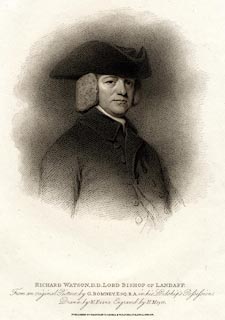
Bishop of Llandaff, Richard Watson
N 54° 21.845 W 002° 55.245
30U E 505149 N 6024033
Richard Watson was educated at Heversham Grammar School and Trinity College, Cambridge. He went on to be Bishop of Llandaff, after a professorship in chemistry, then religion. He was inventor of the cylinder method of charcoal production.
Waymark Code: WMCF8D
Location: North West England, United Kingdom
Date Posted: 08/31/2011
Views: 3
Richard Watson is buried in Bowness-on-Windermere churchyard because he bought the Calgarth Estate and lived for a time at Calgarth Hall. He is best known locally as the inventor of superior charcoal by the cylinder method. This superior charcoal was used in the production of gunpowder. And such metal retorts can be seen in many places acting as gate posts. The Cylinders Estate is Langdale is so named. Superior charcoal produced better gunpowder which meant you engage the enemy from further away.
 From Old Cumbria Gazetteer Print, uncoloured mezzotint, portrait, Richard Watson, DD Lord Bishop of Landaff, from a painting by George Romney, drawn by W Evans, engraved by H Meyer, published by T Cadell and W Davies, Strand, London, 1809.
From Old Cumbria Gazetteer Print, uncoloured mezzotint, portrait, Richard Watson, DD Lord Bishop of Landaff, from a painting by George Romney, drawn by W Evans, engraved by H Meyer, published by T Cadell and W Davies, Strand, London, 1809.
His father was headmaster at Heversham Grammar School and Watson, junior, went to Cambridge at 16 to study mathematics and classics. He matriculated as Second Wrangler. First place was given for political reasons. When a chair of chemistry became vacant Watson applied for the job, despite knowing nothing about chemistry. No stipend was attached to this chair so Watson canvassed for one. On winning the post Watson immersed himself in 14 months of self study with the help of a French laboratory technician before delivering a series of well attended remarkable lectures.
Later the chair of Divinity became vacant with a £500 stipend, so Watson applied for it to further his career. Whilst at Cambridge he brought in many education and exam reforms which are still followed today.
Grave slab is at east end of church, hard against the wall. Words on grave written in Latin. His wife is buried here also.
Watson, Richard. Complete Dictionary of Scientific Biography. 2008. Encyclopedia.com.
PDF download of his life 1.1 Mb